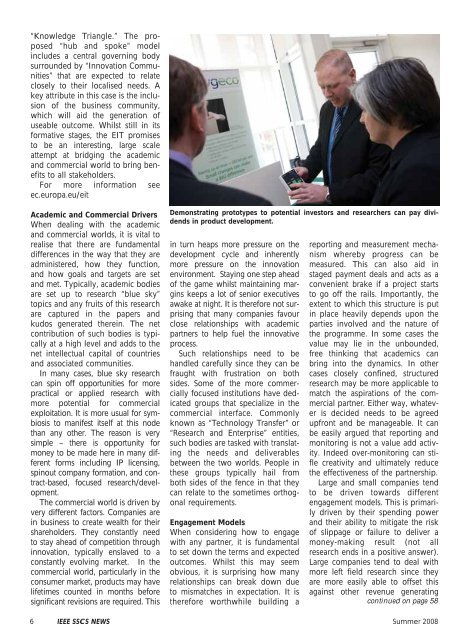Eric Vittoz - IEEE
Eric Vittoz - IEEE
Eric Vittoz - IEEE
Create successful ePaper yourself
Turn your PDF publications into a flip-book with our unique Google optimized e-Paper software.
“Knowledge Triangle.” The proposed<br />
“hub and spoke” model<br />
includes a central governing body<br />
surrounded by “Innovation Communities”<br />
that are expected to relate<br />
closely to their localised needs. A<br />
key attribute in this case is the inclusion<br />
of the business community,<br />
which will aid the generation of<br />
useable outcome. Whilst still in its<br />
formative stages, the EIT promises<br />
to be an interesting, large scale<br />
attempt at bridging the academic<br />
and commercial world to bring benefits<br />
to all stakeholders.<br />
For more information see<br />
ec.europa.eu/eit<br />
Academic and Commercial Drivers<br />
When dealing with the academic<br />
and commercial worlds, it is vital to<br />
realise that there are fundamental<br />
differences in the way that they are<br />
administered, how they function,<br />
and how goals and targets are set<br />
and met. Typically, academic bodies<br />
are set up to research “blue sky”<br />
topics and any fruits of this research<br />
are captured in the papers and<br />
kudos generated therein. The net<br />
contribution of such bodies is typically<br />
at a high level and adds to the<br />
net intellectual capital of countries<br />
and associated communities.<br />
In many cases, blue sky research<br />
can spin off opportunities for more<br />
practical or applied research with<br />
more potential for commercial<br />
exploitation. It is more usual for symbiosis<br />
to manifest itself at this node<br />
than any other. The reason is very<br />
simple – there is opportunity for<br />
money to be made here in many different<br />
forms including IP licensing,<br />
spinout company formation, and contract-based,<br />
focused research/development.<br />
The commercial world is driven by<br />
very different factors. Companies are<br />
in business to create wealth for their<br />
shareholders. They constantly need<br />
to stay ahead of competition through<br />
innovation, typically enslaved to a<br />
constantly evolving market. In the<br />
commercial world, particularly in the<br />
consumer market, products may have<br />
lifetimes counted in months before<br />
significant revisions are required. This<br />
Demonstrating prototypes to potential investors and researchers can pay dividends<br />
in product development.<br />
in turn heaps more pressure on the<br />
development cycle and inherently<br />
more pressure on the innovation<br />
environment. Staying one step ahead<br />
of the game whilst maintaining margins<br />
keeps a lot of senior executives<br />
awake at night. It is therefore not surprising<br />
that many companies favour<br />
close relationships with academic<br />
partners to help fuel the innovative<br />
process.<br />
Such relationships need to be<br />
handled carefully since they can be<br />
fraught with frustration on both<br />
sides. Some of the more commercially<br />
focused institutions have dedicated<br />
groups that specialize in the<br />
commercial interface. Commonly<br />
known as “Technology Transfer” or<br />
“Research and Enterprise” entities,<br />
such bodies are tasked with translating<br />
the needs and deliverables<br />
between the two worlds. People in<br />
these groups typically hail from<br />
both sides of the fence in that they<br />
can relate to the sometimes orthogonal<br />
requirements.<br />
Engagement Models<br />
When considering how to engage<br />
with any partner, it is fundamental<br />
to set down the terms and expected<br />
outcomes. Whilst this may seem<br />
obvious, it is surprising how many<br />
relationships can break down due<br />
to mismatches in expectation. It is<br />
therefore worthwhile building a<br />
reporting and measurement mechanism<br />
whereby progress can be<br />
measured. This can also aid in<br />
staged payment deals and acts as a<br />
convenient brake if a project starts<br />
to go off the rails. Importantly, the<br />
extent to which this structure is put<br />
in place heavily depends upon the<br />
parties involved and the nature of<br />
the programme. In some cases the<br />
value may lie in the unbounded,<br />
free thinking that academics can<br />
bring into the dynamics. In other<br />
cases closely confined, structured<br />
research may be more applicable to<br />
match the aspirations of the commercial<br />
partner. Either way, whatever<br />
is decided needs to be agreed<br />
upfront and be manageable. It can<br />
be easily argued that reporting and<br />
monitoring is not a value add activity.<br />
Indeed over-monitoring can stifle<br />
creativity and ultimately reduce<br />
the effectiveness of the partnership.<br />
Large and small companies tend<br />
to be driven towards different<br />
engagement models. This is primarily<br />
driven by their spending power<br />
and their ability to mitigate the risk<br />
of slippage or failure to deliver a<br />
money-making result (not all<br />
research ends in a positive answer).<br />
Large companies tend to deal with<br />
more left field research since they<br />
are more easily able to offset this<br />
against other revenue generating<br />
continued on page 58<br />
6 <strong>IEEE</strong> SSCS NEWS Summer 2008




